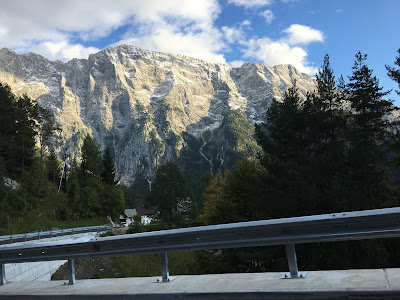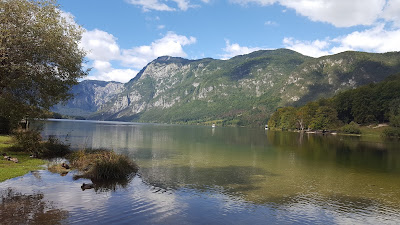
We met Elder & Sister Randall, (Senior Couple from the Mission Office staff), early one morning in the church parking lot of Zagreb. We jumped into their car and traveled west, passing through the border into Slovenia heading towards our ultimate goal ...The Julian Alps.
First stop was at Lake Bled which is famous for it's castle resting on a high rocky ledge.

Also in the middle of the lake is the Bled Island which has several buildings. The main one being the pilgrimage church built in the 17th century.
We didn't have time to stop for long here so we will hopefully be back to visit the castle and the island (Stay tuned!)
Next along our route came Lake Bohinj. It has the most majestic and beautiful view I think we have seen yet. We are hoping our next year's Senior Conference will be held here.
Outside of Bohinj we ate our picnic lunch and waited for the car-train to arrive.


We visited with people from Seattle and Israel, who were also waiting and took the opportunity to share with them why we were living in Croatia and a short spiritual message.
Watching the train pull into the station, we counted about five auto carrier cars. You can all image Elder Crnich's excitement as we drove the car up the ramp and onto the car for our 30 minute ride "through the mountains". The first section included a 6 minute ride through a dark tunnel. We had to turn the lights on just to see how big the tunnel was....not very big...as the engine took up all the space of the opening.

We weren't in it long enough to hyperventilate but were still glad to come out on the other side and view the beautiful valley along the river. This tunnel road is used to shave off nearly a two and half hour drive over the mountain to reach this side of Slovenia. Many bicycle riders also hopped on as well as people working in Italy.

 Yes the water really is this color!
Yes the water really is this color!Arriving on the other side we continued our road trip up the northwest side of Slovenia arriving at a town called Kobaird which houses a World War I Museum. The Museum is dedicated to the events of the First World War. During the war, the whole area was the theatre of the "Battles of the Isonzo", fought between the Kingdom of Italy and Austria-Hungary. At the outset of World War I, the area saw one of the first victims of the conflict: Countess Lucy Christainigg, killed during a mission for the Red Cross. The town was almost completely destroyed between 1915 and 1917. Of note: Ernest Heminway in his novel A Farewell to Arms, documented the Italian retreat from "The Battle of Caporetto" in 1917. Nearly 11 million people lost their lives during this war, in the mountains surrounding Kobaird.
 Leaving the sadness of the museum we traveled through the beautiful Julian Alps, totally in awe of their grandeur and scale, which pictures cannot capture. We followed the road through the valley where archaeological sites have remains of 5th century Roman buildings and roads.
Leaving the sadness of the museum we traveled through the beautiful Julian Alps, totally in awe of their grandeur and scale, which pictures cannot capture. We followed the road through the valley where archaeological sites have remains of 5th century Roman buildings and roads.We drove through an ancient fortress which was built on the pass of Predril, where in 1806 a battle was fought between Napoleon French forces and Austrians.



The Austrians lost the battle and were buried in a mass grave near the fortress.
Our day ended at the Italian border with a room in a delightful B&B operated by a Slovene family with two small children.
 That evening we were treated to fantastic meal of pumpkin soup, freshly picked mushroom pasta, fresh bread, and delicious greens all served next to a wonderfully warm wood burning stove. Food never tasted so good!
That evening we were treated to fantastic meal of pumpkin soup, freshly picked mushroom pasta, fresh bread, and delicious greens all served next to a wonderfully warm wood burning stove. Food never tasted so good!Breakfast the next morning was equally wonderful. Mountain eggs, fresh bread, creamy yogurt, fresh fruit and traditional "palatschenken" started our day off with pleasure.

Before leaving we walked about 50 feet to the Italy border...an NO we did not cross over the line. Our mission area ends in Slovenia!

Elder Crnich again found his favorite sight...sheep along the road, keeping the mountain pastures neat and trim.

Our journey towards home today found us traveling through the mountains of the Triglavski Narodni Park on a road built by 10,000 Russian prisoners of WW1. The road was built to haul supplies through the steep mountains to armies near Kobaird. At one point there was a huge cable system which transported goods down the mountain when the weather was too harsh to travel on the roads.
There were 50 switch backs which made driving fun and exciting as we often met other cars, large trucks, and bicyclists on the narrow windy road.

We met many motorcyclists, each leaning into the corners at many of the turns. One particularly exciting event was watching two motorcycles meet a large tour bus on the corner switchback. Yes...they came to a complete stop!

Reaching the Vršič Pass summit, 1783m (5883 feet) we stopped to admire the miles of mountain vistas and valleys below.


Following the often cobblestoned road, we stopped at a Russian Orthodox Chapel tucked away in the forest.

In 1916, while building the Russian road, a landslide hit the POW camp, killing 110 Russians and their 7 guards. The chapel was built by Russian workers as a monument to their nearly 380 countrymen who were killed during the building of the road across the Vršič Pass.
We ended our travels with a quick stop at the river park at Mojstrana and admired the beautiful color of the river flowing from the Julian Alps.
































